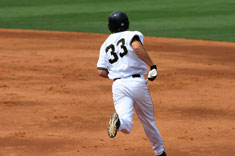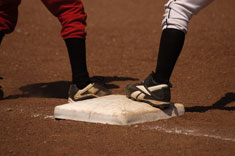
You're free to run, but it's risky
 |
As we mentioned in the Overview, an offensive player scores a run by completing a circuit around the bases, touching them in sequence. He usually proceeds from base to base with the help of his teammates as they take their turns at bat.
Definitions
Batter-runner: The batter must proceed toward first base (or beyond) when he is awarded a base or when he hits a fair-ball. Until the action of proceeding to first base or beyond stops, he is the batter-runner. This is a technical term writers use for clarity: you won't hear it in conversation.
Runner: When the above action pauses, a batter-runner who has not made an out (who is "safe") and who occupies first, second, or third base is called simply a runner.
Basic Principles of Base Running
Bases are islands of safety. If a runner has the right to occupy a certain base and is touching it with any part of his body, he cannot make an out.
There can be up to three runners at a time in addition to a batter-runner.
But a base is a safe haven for only one offensive player at a time. If two of them find themselves on the same base, one of them has made a bad mistake and is at risk of making an out until he returns to a base that he has a right to occupy.
A batter-runner or runner is automatically out whenever and wherever he passes another runner.
 |
| By their uniforms, one must be offense and the other defense. The former is "on" the base, and the latter will try to get him "out" if he wanders off of it. |
Runners do not have to stand on "their" base.
What is more, a runner is free to try to
advance around the bases to home plate at almost
any time. This is extremely important to realize. It makes no difference whether the current batter has hit the baseball, or whether the pitcher is pitching or just
holding the ball, or ... almost any situation. It may appear
that runners are obliged to stand on or near a base, but
they usually are just being cautious. In fact, fast
runners often try to steal a base,
that is, run to it when the batter has not hit the baseball.
Exceptions to the freedom of runners to run when they want:
Exception 1: A runner cannnot advance when there is a time-out. There are a lot of brief time-outs, some of them automatic, for example, when the umpire has to give the pitcher a new baseball or when a foul-ball is not caught before it bounces.
Exception 2: When a foul ball or a a fair ball is caught before it bounces, the runner may not advance until it's caught. NB: he can advance as soon as it's caught.
The Reason for Exception 2
Remember that the batter is out if the defense catches a fly ball, a batted baseball that has never touched the ground. It makes no difference whether it is a fair ball or a foul ball. If Exception 2 didn't exist, a batter could intentionally hit a baseball straight up in the air so that runners could circle the bases and score even if the defense eventually caught it. It would be easy and silly.
Now, as soon as the defense catches a fly ball, the runner can try to advance provided that he starts his race by being in contact with his current base. This rule creates exciting situations when a baseball is hit a long distance in the air. The runner often hesitates half way between one base and another, judging whether or not the defense is going to catch the baseball and whether or not they can get the baseball to the next base before he arrives at it, which could make him out. (See the next page.)
Note that this is the only situation when runners may advance when there is a foul ball. While runners frequently try to take advantage of fair fly balls that are caught, they try only once every six or seven games, perhaps, when it's a question of a foul ball. It's simply geometry: foul territory tends to be small and relatively close to the bases. In any event, this is why we introduced the concept of a foul-ball as "almost always not good for the offense".



